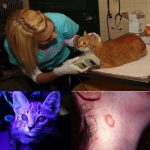Ringworm In Your Dog, Cat And Other Pets
Ron Hines DVM PhD

What Is Ringworm? Is It A Worm?
Ringworm is not a worm, it is a fungus. There are several species, the most common one is Microsporum canis, but Microsporum gypseum, and Trichophyton. infect dogs and cats as well. None of these organisms are particular about what species they infect. Their spores can spread to you too. (read here) In cats, Microsporum canis is the most common one isolated. (read here) Although dogs are somewhat less likely to catch it, M. canis is the most common one in dogs as well. These superficial fungi feed on the outer layers of skin. As the fungus spreads from a central point in a ring-like circle, the center portion begins to heal and regrow broken hairs. That gives it a central scaly or scurfy appearance. With the active areas along the outer edge giving it a pinkish outer ring-like appearance. In most cases, these areas are painless. The fungus is feeding on the keratin that makes up hair and the outer layers of skin (they are keratinophilic). But in a few cases, for unknown reasons they itch. Pet shop exotics are just as likely to arrive infected, that goes for rabbits, hedgehogs, ferret. Ferrets very rarely leave major breeders infected with ringworm. It is unsanitary, crowded pet store facilities spread the fungus around. That goes for pet shop puppies and kittens as well. When these fungi transfer to pet owners who perhaps scratched their head, it is called tinea capitis.
Are Some Pets And People Resistant?
Yes
Contact with these fungi do not always lead to infection. Once exposed to these fungi, health pets and people build up an immunity to reinfection. (read here) However that immunity is often not complete. Pets can look perfectly normal due to their resistance but still be able to spread the fungus to others.
The same occurs in people like veterinarians and kennel workers who spend a lot of their lives in contact with these fungi. I recall that as a young veterinarian I once developed a small ringworm lesion on my arm. But in my long career thereafter as a veterinarian treating dozens and dozens of ringworm cats, I never developed one a second time. The most likely pets to catch ringworm are pets less than one year old, and stressed, crowded shelter animals. Ringworm immunity can also lessen in the very old or the very ill.
How Will My Veterinarian Diagnose Ringworm?
The tool that veterinarians use to detect ringworm is called a Wood’s lamp. In a darkened room most M. canis infected hairs will fluoresce an apple green color under the ultraviolet lamp light. Scurf, scabs, blood, and certain bacterial infections will also fluoresce. But the pinpoint glowing areas within hairs adjacent to the lesions of ringworm are quite distinctive. Usually scurf, scabs, blood, and bacterial will glow more blue than the distinctive green of ringworm. Some applied topical medications will also fluoresce.
The Wood’s lamp is a very effective tool to detect infected pets. It is less effective in monitoring the effectiveness of treatment since every last fungus must be eliminated. For that, the most certain test is for your veterinarian to take a pinch of the surrounding hairs and scraping and send them off for fungal culture. If no fungal growth occurs in the laboratory, the pet is cured. Because fungi grow slowly, that test takes 7–21 days to complete. Idexx Laboratories offers a rapid PCR-based ringworm test with results available in 1–3 working days. However, that test is prone to false positive results because of lingering non-living ringworm fungus remnants. Antech Laboratories, a division of VCA, offers both culture and PCR to your veterinarian.
How Will My Veterinarian Cure A Ringworm Infection?
Skin Treatments:
All ringworm patches need to be clipped with surgical-blade electric pet clippers and then washed with povidone iodine scrub to remove as many infected hair shafts and fungus spores as possible. Those clippers then need to be disinfected. That will not cure your cat, but it will help in keeping new ringworm areas from forming. Whole-body clipping is never a good idea because it spreads infective ringworm spores to unaffected areas and can be highly stressful to un-anesthetized or non-tranquilized pets.
Various shampoos and rinses are effective in killing these fungi. They include lime sulfur (which smells horrible), combinations of miconazole and chlorhexidine (but neither alone) and enilconazole shampoos As I write, enilconazole (Imaverol®) is available in Europe, but not in North America. Ketoconazole shampoos are available here, but I am hesitant to use them over large areas on pets – particularly those that might lick it off. (read here) Experimentally, topical terbinafine (Lamisil®) will also kill ringworm. (read here) But we really do not know if using it topically just makes pets asymptomatic carriers.
Oral Treatments:
Ideally, pets receive an oral medication as well. My choice is usually itraconazole (Sporanox®). Its primary use in people is as a cure for fingernails and toenail fungus. When given orally, it persists in the fur and skin for quite some time. So, it can be given at the proper dose for perhaps a week and on an off-a-week-on-a-week schedule. It is wise to halt the medication if your pet’s liver enzymes (e.g. ALT) begin to rise while on the drug or if your pet loses its appetite. Google it’s many other possible but uncommon side effects online.
Terbinafine can also be given orally. It also accumulates in the fur and skin, allowing the drug to be given in pulses to decrease expense and the possibility of side effects. Again, monitoring your pet’s liver enzymes during treatment is always a good idea. Terbinafine takes longer to effect a complete cure. (read here)
How Long Will Treatment Take?
Three to four weeks of treatment is commonly required. (read here)
How Can I Be Certain That My Pet No Longer Carries The Fungus?
As I mentioned, return to a normal hair coat does not necessarily mean that your pet no longer carries the fungus. The rapid PCR technique I mentioned earlier denotes a full cure when the report comes back to your veterinarian as negative. But when it reports back that fungus are still present, it can just be because dead fungi still contaminate your pet’s skin and fur. Only negative fungal cultures can confirm a complete cure. That is particularly important in kennel and cattery environments that are trying to rid their premises of this parasitic fungi. Long-haired cat breeders seem to have the most difficult time ridding their premises of subclinical carriers. (read here)
How Can I Decontaminate My Home?
Frequent vacuuming of your home with one-time-use, HEPA grade vacuum cleaner bags is quite effective when it is combined with pet shampoos. Ordinary 5.25% household bleach diluted 1:100 also effectively kills fungus spores on hard surfaces. Fabrics and clothing that are “bleach safe/color fast” can be machine washed with an added 2-3 tsp household bleach per load.
You are on the Vetspace animal health website
Visiting the products that you see displayed on this website help pay the cost of keeping these articles on the Internet.




